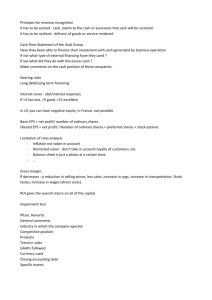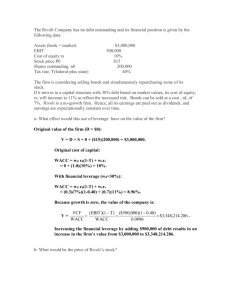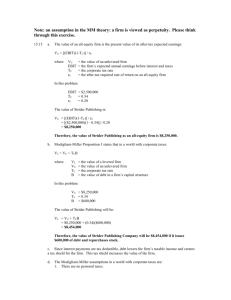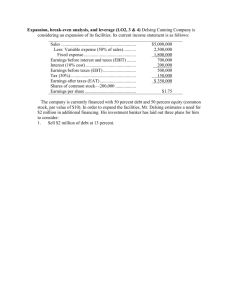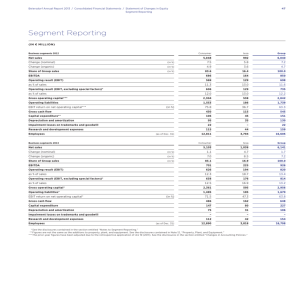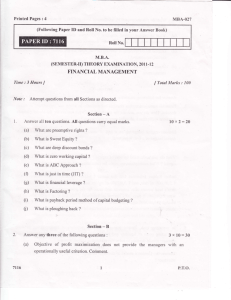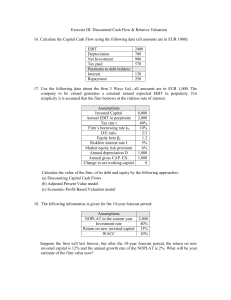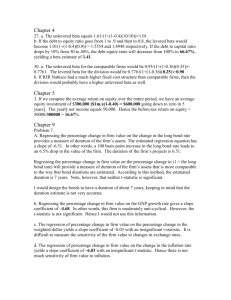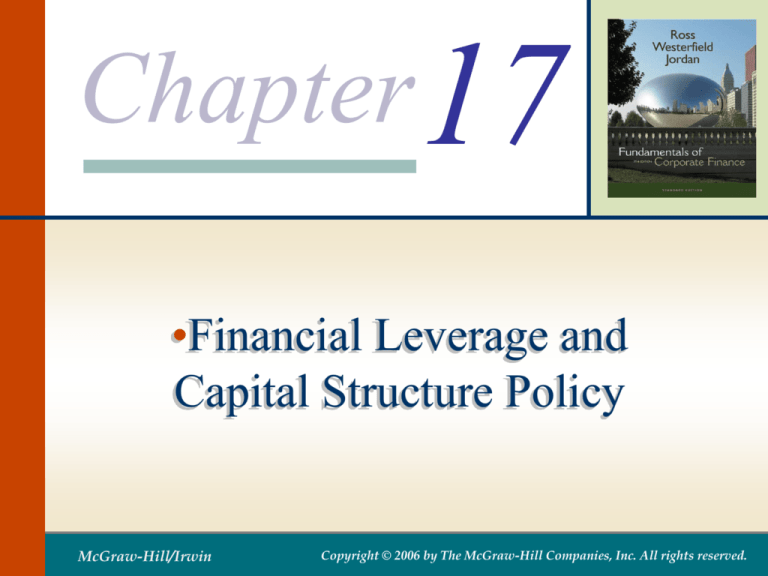
Chapter 17
•Financial Leverage and
Capital Structure Policy
McGraw-Hill/Irwin
Copyright © 2006 by The McGraw-Hill Companies, Inc. All rights reserved.
Questions and Problems
• 1. EBIT and Leverage
• Money SpA, has no debt outstanding and a total
market value of €150,000. Earnings before
interest and taxes, EBIT, are projected to be
€15,000 if economic conditions are normal. If
there is strong expansion in the economy, then
EBIT will be 30 percent higher. If there is a
recession, then EBIT will be 60 percent lower.
Money is considering a €60,000 debt issue with
a 5 percent interest rate. The proceeds will be
used to repurchase shares of stock. There are
currently 2,500 shares outstanding. Ignore taxes
for this problem.
17-1
• a. Calculate earnings per share, EPS,
under each of the three economic
scenarios before any debt is issued. Also,
calculate the percentage changes in EPS
when the economy expands or enters a
recession.
• b. Repeat part (a) assuming that Money
goes through with recapitalization. What do
you observe?
17-2
• 1. a. A table outlining the income
statement for the three possible states of
the economy is shown below. The EPS is
the net income divided by the 2,500 shares
outstanding. The last row shows the
percentage change in EPS the company
will experience in a recession or an
expansion economy.
17-3
EBIT
Interest
NI
EPS
%EPS
Recession
Normal
Expansion
€6,000
€15,000
€19,500
0
0
0
€6,000
€15,000
€19,500
€ 2.40
€ 6.00
€ 7.80
–60
–––
+30
17-4
• b. If the company undergoes the proposed
recapitalization, it will repurchase:
• Share price = Equity / Shares outstanding
• Share price = €150,000/2,500
• Share price = €60
• Shares repurchased = Debt issued / Share
price
• Shares repurchased =€60,000/€60
• Shares repurchased = 1,000
17-5
• The interest payment each year under all
three scenarios will be:
• Interest payment = €60,000(.05) = €3,000
• The last row shows the percentage change
in EPS the company will experience in a
recession or an expansion economy under
the proposed recapitalization.
17-6
EBIT
Interest
NI
EPS
%EPS
Recession
Normal
Expansion
€6,000
€15,000
€19,500
3,000
3,000
3,000
€3,000
€12,000
€16,500
€2.00
€ 8.00
€11.00
–75.00
–––
+37.50
17-7
• 2. EBIT, Taxes, and Leverage
• Repeat parts (a) and (b) in Problem 1
assuming Money has a tax rate of 35
percent.
17-8
• a. A table outlining the income statement
with taxes for the three possible states of
the economy is shown below. The share
price is still €60, and there are still 2,500
shares outstanding. The last row shows
the percentage change in EPS the
company will experience in a recession or
an expansion economy.
17-9
EBIT
Interest
Taxes
NI
EPS
%EPS
Recession
Normal
Expansion
€6,000
€15,000
€19,500
0
0
0
2,100
5,250
6,825
€3,900
€9,750
€12,675
€1.56
€3.90
€5.07
–60
–––
+30
17-10
•
b. A table outlining the income
statement with taxes for the three possible
states of the economy and assuming the
company undertakes the proposed
capitalization is shown below. The interest
payment and shares repurchased are the
same as in part b of Problem 1.
17-11
Recession
Normal
Expansion
€6,000
€15,000
€19,500
Interest
3,000
3,000
3,000
Taxes
1,050
4,200
5,775
€1,950
€7,800
€10,725
€1.30
€5.20
€7.15
–75.00
–––
+37.50
EBIT
NI
EPS
%EPS
17-12
• Notice that the percentage change in EPS
is the same both with and without taxes.
17-13
• 3. ROE and Leverage
• Suppose the company in Problem 1 has a
market-to-book ratio of 1.0.
• a. Calculate return on equity, ROE, under each of
the three economic scenarios before any debt is
issued. Also, calculate the percentage changes
in ROE for economic expansion and recession,
assuming no taxes.
• b. Repeat part (a) assuming the firm goes
through with the proposed recapitalization.
• c. Repeat parts (a) and (b) of this problem
assuming the firm has a tax rate of 35 percent.
17-14
• 3. a.Since the company has a market-tobook ratio of 1.0, the total equity of the firm
is equal to the market value of equity.
Using the equation for ROE:
• ROE = NI/€150,000
• The ROE for each state of the economy
under the current capital structure and no
taxes is:
17-15
Recession
Normal
Expansion
ROE
.04
.10
.13
%ROE
–60
–––
+30
17-16
• The second row shows the percentage
change in ROE from the normal economy.
17-17
• b. If the company undertakes the
proposed recapitalization, the new equity
value will be:
• Equity = €150,000 – 60,000
• Equity = €90,000
• So, the ROE for each state of the economy
is:
• ROE = NI/€90,000
17-18
ROE
%ROE
Recession
Normal
Expansion
.0333
.1333
.1833
–75.00
–––
+37.50
17-19
• c. If there are corporate taxes and the
company maintains its current capital
structure, the ROE is:
17-20
ROE
%ROE
.0260
.0650
.0845
–60
–––
+30
17-21
• If the company undertakes the proposed
recapitalization, and there are corporate
taxes, the ROE for each state of the
economy is:
17-22
ROE
%ROE
.0217
.0867
.1192
–75.00
–––
+37.50
17-23
• Notice that the percentage change in ROE
is the same as the percentage change in
EPS. The percentage change in ROE is
also the same with or without taxes.
17-24
• 4. Break-Even EBIT
• Shantou Beverage is comparing two different capital
structures, an all-equity plan (Plan I) and a levered plan
(Plan II). Under Plan I, Shantou would have 150,000
shares of stock outstanding. Under Plan II, there would
be 60,000 shares of stock outstanding and 15 million
yuan in debt outstanding. The interest rate on the debt is
10 percent and there are no taxes.
• a. If EBIT is 2 million yuan, which plan will result in the
higher EPS?
• b. If EBIT is 7 million yuan, which plan will result in the
higher EPS?
• c. What is the break-even EBIT?
17-25
• 4. a. Under Plan I, the unlevered company,
net income is the same as EBIT with no
corporate tax. The EPS under this
capitalization will be:
• EPS = CNY2,000,000/150,000 shares
• EPS = CNY13.33
17-26
• Under Plan II, the levered company, EBIT
will be reduced by the interest payment.
The interest payment is the amount of debt
times the interest rate, so:
• NI = CNY2,000,000 – .10(CNY15,000,000)
• NI = CNY500,000
17-27
•
•
•
•
And the EPS will be:
EPS = CNY500,000/60,000 shares
EPS = CNY8.33
Plan I has the higher EPS when EBIT is
CNY2,000,000.
17-28
• b. Under Plan I, the net income is
CNY7,000,000 and the EPS is:
• EPS = CNY7,000,000/150,000 shares
• EPS = CNY46.67
• Under Plan II, the net income is:
• NI = CNY7,000,000 – .10(CNY15,000,000)
• NI = CNY5,500,000
17-29
•
•
•
•
And the EPS is:
EPS = CNY5,500,000/60,000 shares
EPS = CNY91.67
Plan II has the higher EPS when EBIT is
CNY7,000,000.
17-30
• c. To find the breakeven EBIT for two
different capital structures, we simply set
the equations for EPS equal to each other
and solve for EBIT. The breakeven EBIT is:
• EBIT/150,000 = [EBIT –
.10(CNY15,000,000)]/60,000
• EBIT = CNY2,500,000
17-31
• 5. M&M and Stock Value
• In Problem 4, use M&M Proposition I to
find the price per share of equity under
each of the two proposed plans. What is
the value of the firm?
17-32
• 5. We can find the price per share by dividing
the amount of debt used to repurchase shares by
the number of shares repurchased. Doing so, we
find the share price is:
• Share price = CNY15,000,000/(150,000 – 60,000)
• Share price = CNY166.67 per share
• The value of the company under the all-equity
plan is:
• V = CNY166.67(150,000 shares) =
CNY2,500,500
17-33
• And the value of the company under the
levered plan is:
• V = CNY166.67(60,000 shares) +
CNY15,000,000 debt = CNY2,500,200
17-34
• 6. Break-Even EBIT and Leverage Malang Fabric
Manufacturing is comparing two different capital
structures. Plan I would result in 1,100 shares of
stock and 17 million rupiahs in debt. Plan II
would result in 900 shares of stock and 28 million
rupiahs in debt. The interest rate on the debt is
10 percent.
• a. Ignoring taxes, compare both of these plans to
an all-equity plan assuming that EBIT will be 10
million rupiahs. The all-equity plan would result in
1,400 shares of stock outstanding. Which of the
three plans has the highest EPS? The lowest?
17-35
• b. In part (a), what are the break-even
levels of EBIT for each plan as compared
to that for an all-equity plan? Is one higher
than the other? Why?
• c. Ignoring taxes, when will EPS be
identical for Plans I and II?
• d. Repeat parts (a), (b), and (c) assuming
that the corporate tax rate is 40 percent.
Are the break-even levels of EBIT different
from before? Why or why not?
17-36
6.
a.
EBIT
Interest
NI
EPS
The income statement for each capitalization plan is:
I
II
All-Equity
INR10,000,000
INR10,000,000
INR10,000,000
1,700,000
2,800,000
-
INR8,300,000
INR7,200,000
INR10,000,000
INR7,545.45
INR8,000.00
INR7,142.86
17-37
• Plan II has the highest EPS; the all-equity
plan has the lowest EPS.
17-38
• b. The breakeven level of EBIT occurs when the
capitalization plans result in the same EPS. The
EPS is calculated as:
• EPS = (EBIT – RDD)/Shares outstanding
• This equation calculates the interest payment
(RDD) and subtracts it from the EBIT, which
results in the net income. Dividing by the shares
outstanding gives us the EPS. For the all-equity
capital structure, the interest term is zero. To find
the breakeven EBIT for two different capital
structures, we simply set the equations equal to
each other and solve for EBIT.
17-39
• The breakeven EBIT between the all-equity
capital structure and Plan I is:
• EBIT/1,400 = [EBIT – .10(INR17,000,00)]/1,100
• EBIT = INR7,933,333
• And the breakeven EBIT between the all-equity
capital structure and Plan II is:
• EBIT/1,400 = [EBIT – .10(INR28,000,000)]/900
•
EBIT = INR7,840,000
17-40
• c. Setting the equations for EPS from Plan
I and Plan II equal to each other and
solving for EBIT, we get:
• [EBIT – .10(INR17,000,000)]/1,100 =
[EBIT – .10(INR28,000,000)]/900
• EBIT = INR7,750,000
17-41
d.
The income statement for each capitalization plan with corporate income taxes is:
I
II
All-equity
EBIT
INR10,000,000
Interest
1,700,000
2,800,000
-
Taxes
3,320,000
2,880,000
4,000,000
INR4,980,000
INR4,320,000
INR6,000,000
INR 4,527
INR4,800
INR4,286
NI
EPS
INR10,000,000 INR10,000,000
17-42
• Plan II still has the highest EPS; the allequity plan still has the lowest EPS.
• We can calculate the EPS as:
• EPS = [(EBIT – RDD)(1 – tC)]/Shares
outstanding
• This is similar to the equation we used
before, except now we need to account for
taxes. Again, the interest expense term is
zero in the all-equity capital structure.
17-43
• So, the breakeven EBIT between the all-equity
plan and Plan I is:
• EBIT(1 – .40)/1,400 = [EBIT –
.10(INR17,000,000)](1 – .40)/1,100
• EBIT = INR7,933,333
• The breakeven EBIT between the all-equity plan
and Plan II is:
• EBIT(1 – .40)/1,400 = [EBIT –
.10(INR28,000,000)](1 – .40)/900
• EBIT = INR7,840,000
17-44
• And the breakeven between Plan I and Plan II is:
• [EBIT – .10(INR17,000,000)](1 – .40)/1,100 =
[EBIT – .10(INR28,000,000)](1 – .40)/900
• EBIT = INR7,750,000
• The break-even levels of EBIT do not change
because the addition of taxes reduces the
income of all three plans by the same
percentage; therefore, they do not change
relative to one another.
17-45
• 7. Leverage and Stock Value
• Ignoring taxes in Problem 6, what is the
price per share of equity under Plan I?
Plan II? What principle is illustrated by your
answers?
17-46
• 7. To find the value per share of the stock
under each capitalization plan, we can
calculate the price as the value of shares
repurchased divided by the number of
shares repurchased. So, under Plan I, the
value per share is:
•
P = INR11,000,000/200 shares
•
P = INR55,000 per share
17-47
• And under Plan II, the value per share is:
• P = INR28,000,000/500 shares
• P = INR56,000 per share
17-48
• 8. Homemade Leverage Valencia Items, a
prominent consumer products firm, is
debating whether or not to convert its allequity capital structure to one that is 40
percent debt. Currently, there are 2,000
shares outstanding and the price per share
is 70 euros. EBIT is expected to remain at
16,000 euros per year forever. The interest
rate on new debt is 10 percent, and there
are no taxes.
17-49
• a. Ms. Aznar, a shareholder of the firm, owns 100
shares of stock. What is her cash flow under the
current capital structure, assuming the firm has a
dividend payout rate of 100 percent?
• b. What will Ms. Aznar's cash flow be under the
proposed capital structure of the firm? Assume
that she keeps all 100 of her shares.
• c. Suppose Valencia does convert, but Ms. Aznar
prefers the current all-equity capital structure.
Show how she could unlever her shares of stock
to recreate the original capital structure.
• d. Using your answer to part (c), explain why
Valencia's choice of capital structure is irrelevant.
17-50
•
•
•
•
•
•
8. a. The earnings per share are:
EPS = €16,000/2,000 shares
EPS = €8.00
So, the cash flow for the company is:
Cash flow = €8.00(100 shares)
Cash flow = €800
17-51
• b. To determine the cash flow to the
shareholder, we need to determine the
EPS of the firm under the proposed capital
structure. The market value of the firm is:
•
• V = €70(2,000)
• V = €140,000
17-52
• Under the proposed capital structure, the
firm will raise new debt in the amount of:
•
• D = 0.40(€140,000)
• D = €56,000
• in debt. This means the number of shares
repurchased will be:
• Shares repurchased = €56,000/€70
• Shares repurchased = 800
17-53
• Under the new capital structure, the company will
have to make an interest payment on the new
debt. The net income with the interest payment
will be:
• NI = €16,000 – .10(€56,000)
• NI = €10,400
• This means the EPS under the new capital
structure will be:
• EPS = €10,400/1,200 shares
• EPS = €8.67
17-54
• Since all earnings are paid as dividends,
the shareholder will receive:
•
• Shareholder cash flow = €8.67(100 shares)
• Shareholder cash flow = €866.67
17-55
• c. To replicate the proposed capital
structure, the shareholder should sell 40
percent of their shares, or 40 shares, and
lend the proceeds at 8 percent. The
shareholder will have an interest cash flow
of:
• Interest cash flow = 40(€70)(.10)
• Interest cash flow = €280
17-56
• The shareholder will receive dividend
payments on the remaining 60 shares, so
the dividends received will be:
• Dividends received = €8.67(60 shares)
• Dividends received = €520
17-57
• The total cash flow for the shareholder
under these assumptions will be:
•
• Total cash flow = €280 + 520
• Total cash flow = €800
• This is the same cash flow we calculated in
part a.
17-58
• d. The capital structure is irrelevant
because shareholders can create their own
leverage or unlever the stock to create the
payoff they desire, regardless of the capital
structure the firm actually chooses.
17-59
• 9. Homemade Leverage and WACC
• ABC Co. and XYZ Co. are identical firms in
all respects except for their capital
structure. ABC is all-equity financed with
$600,000 in stock. XYZ uses both stock
and perpetual debt; its stock is worth
$400,000 and the interest rate on its debt
is 9 percent. Both firms expect EBIT to be
$75,000. Ignore taxes.
17-60
• a. Rico owns $30,000 worth of XYZ's stock.
What rate of return is she expecting?
17-61
• a. The rate of return earned will be the dividend
yield. The company has debt, so it must make an
interest payment. The net income for the
company is:
•
NI = $75,000 – .09($400,000)
•
NI = $39,000
• The investor will receive dividends in proportion
to the percentage of the company’s share they
own. The total dividends received by the
shareholder will be:
•
17-62
• Dividends received =
$39,000($30,000/$400,000)
• Dividends received = $2,925
• So the return the shareholder expects is:
• R = $2,925/$30,000
• R = .0975 or 9.75%
17-63
• b. Show how Rico could generate exactly
the same cash flows and rate of return by
investing in ABC and using homemade
leverage.
17-64
• b. To generate exactly the same cash
flows in the other company, the
shareholder needs to match the capital
structure of ABC. The shareholder should
sell all shares in XYZ. This will net $30,000.
The shareholder should then borrow
$30,000. This will create an interest cash
flow of:
• Interest cash flow = .09($30,000)
• Interest cash flow = –$2,700
17-65
• The investor should then use the proceeds
of the stock sale and the loan to buy
shares in ABC. The investor will receive
dividends in proportion to the percentage
of the company’s share they own. The total
dividends received by the shareholder will
be:
• Dividends received =
$75,000($60,000/$600,000)
• Dividends received = $7,500
17-66
• The total cash flow for the shareholder will
be:
•
• Total cash flow = $7,300 – 2,700
• Total cash flow = $4,800
• The shareholders return in this case will be:
• R = $4,800/$30,000
• R = .1600 or 16.00%
17-67
• c. What is the cost of equity for ABC? What
is it for XYZ?
17-68
•
•
•
•
c. ABC is an all equity company, so:
RE = RA = $75,000/$600,000
RE = .1250 or 12.50%
To find the cost of equity for XYZ we need
to use M&M Proposition II, so:
• RE = RA + (RA – RD)(D/E)(1 – tC)
• RE = .1250 + (.1250 – .09)(1)(1)
• RE = .1600 or 16.00%
17-69
• d. What is the WACC for ABC? For XYZ?
What principle have you illustrated?
17-70
• d. To find the WACC for each company we
need to use the WACC equation:
• WACC = (E/V)RE + (D/V)RD(1 – tC)
• So, for ABC, the WACC is:
• WACC = (1)(.1250) + (0)(.09)
• WACC = .1250 or 12.50%
17-71
•
•
•
•
And for XYZ, the WACC is:
WACC = (1/2)(.16) + (1/2)(.09)
WACC = .1250 or 12.50%
When there are no corporate taxes, the
cost of capital for the firm is unaffected by
the capital structure; this is M&M
Proposition I without taxes.
17-72
• 10. M&M
• Nina Corp. uses no debt. The weighted
average cost of capital is 14 percent. If the
current market value of the equity is $40
million and there are no taxes, what is
EBIT?
17-73
• 10.With no taxes, the value of an
unlevered firm is the interest rate divided
by the unlevered cost of equity, so:
• V = EBIT/WACC
• $40,000,000 = EBIT/.14
• EBIT = .14($40,000,000)
• EBIT = $5,650,000
17-74
• 11. M&M and Taxes
• In the previous question, suppose the
corporate tax rate is 35 percent. What is
EBIT in this case? What is the WACC?
Explain.
17-75
• 11. If there are corporate taxes, the value of an
unlevered firm is:
• VU = EBIT(1 – tC)/RU
• Using this relationship, we can find EBIT as:
• $40,000,000 = EBIT(1 – .35)/.14
• EBIT = $8,615,684.62
• The WACC remains at 14 percent.
Due to
taxes, EBIT for an all-equity firm would have to
be higher for the firm to still be worth $40 million.
17-76
• 12. Calculating WACC
• Kota Industries, an Indian-based firm, has a
debt-equity ratio of 1.5. Its WACC is 12 percent,
and its cost of debt is 12 percent. The corporate
tax rate is 35 percent.
• a. What is Kola's cost of equity capital?
• b. What is Kota's unlevered cost of equity capital?
• c. What would the cost of equity be if the debtequity ratio were 2? What if it were 1.0? What if it
were zero?
17-77
• 12. a.With the information provided, we can use
the equation for calculating WACC to find the
cost of equity. The equation for WACC is:
• WACC = (E/V)RE + (D/V)RD(1 – tC)
• The company has a debt-equity ratio of 1.5,
which implies the weight of debt is 1.5/2.5, and
the weight of equity is 1/2.5, so
• WACC = .12 = (1/2.5)RE + (1.5/2.5)(.12)(1 – .35)
• RE = .1830 or 18.30%
17-78
• b. To find the unlevered cost of equity we
need to use M&M Proposition II with taxes,
so:
• RE = RU + (RU – RD)(D/E)(1 – tC)
• .1830 = RU + (RU – .12)(1.5)(1 – .35)
• RU = .1519 or 15.19%
17-79
• c. To find the cost of equity under different
capital structures, we can again use the
WACC equation. With a debt-equity ratio of
2, the cost of equity is:
• .12 = (1/3)RE + (2/3)(.12)(1 – .35)
• RE = .2040 or 20.40%
17-80
• With a debt-equity ratio of 1.0, the cost of
equity is:
• .12 = (1/2)RE + (1/2)(.12)(1 – .35)
• RE = .1620 or 16.20%
• And with a debt-equity ratio of 0, the cost
of equity is:
•
• .12 = (1)RE + (0)(.12)(1 – .35)
• RE = WACC = .12 or 12%
17-81
• 14. M&M and Taxes
• Mumbai Partners expects its EBIT to be 4
million rupees every year forever. The firm
can borrow at 11 percent. Mumbai
currently has no debt, and its cost of equity
is 20 percent. If the tax rate is 35 percent,
what is the value of the firm? What will the
value be if Mumbai borrows 2.5 million
rupees and uses the proceeds to
repurchase shares?
17-82
• 14.
• a. The value of the unlevered firm is:
•
V = EBIT(1 – tC)/RU
•
V = INR4,000,000(1 – .35)/.20
•
V = INR13,000,000
17-83
•
•
•
•
b. The value of the levered firm is:
V = VU + tCD
V = INR13,000,000 + .35(INR2,500,000)
V = INR13,875,000
17-84
• 15. M&M and Taxes
• In Problem 14, what is the cost of equity
after recapitalization? What is the WACC?
What are the implications for the firm's
capital structure decision?
17-85
• 15.We can find the cost of equity using
M&M Proposition II with taxes. Doing so,
we find:
• RE = RU + (RU – RD)(D/E)(1 – t)
• RE = .20 + (.20 –
.11)(INR2,500,000/INR11,375,000)(1 – .35)
• RE = .2129 or 21.29%
17-86
• Using this cost of equity, the WACC for the
firm after recapitalization is:
• WACC = (E/V)RE + (D/V)RD(1 – tC)
• WACC
= .2129(INR11,375,000/INR13,875,000)
+ .11(1 –
.35)(INR2,500,000/INR13,875,000)
• WACC = .1874 or 18.74%
17-87
• When there are corporate taxes, the
overall cost of capital for the firm declines
the more highly leveraged is the firm’s
capital structure. This is M&M Proposition I
with taxes.
17-88
• 16. M&M
• Natal Tool Manufacturing, a firm based in Brazil,
has an expected EBIT of 75,000 reals in
perpetuity and a tax rate of 35 percent. The firm
has 150,000 reals in outstanding debt at an
interest rate of 9 percent, and its unlevered cost
of capital is 14 percent. What is the value of the
firm according to M&M Proposition I with taxes?
Should Natal change its debt-equity ratio if the
goal is to maximize the value of the firm? Explain.
17-89
• 16.To find the value of the levered firm we
first need to find the value of an unlevered
firm. So, the value of the unlevered firm is:
•
VU = EBIT(1 – tC)/RU
•
VU = (BRL75,000)(1 – .35)/.14
•
VU = BRL348,314.29
17-90
•
Now we can find the value of the
levered firm as:
•
VL = VU + tCD
•
VL = BRL348,314.29 + .35(BRL150,000)
•
VL = BRL400,714.29
17-91
•
Applying M&M Proposition I with taxes,
the firm has increased its value by issuing
debt. As long as M&M Proposition I holds,
that is, there are no bankruptcy costs and
so forth, then the company should continue
to increase its debt/equity ratio to
maximize the value of the firm.
17-92
• 17. Firm Value
• Old School NV expects an EBIT of €10,000
every year forever. Old School currently
has no debt, and its cost of equity is 17
percent. The firm can borrow at 10 percent.
If the corporate tax rate is 35 percent, what
is the value of the firm? What will the value
be if Old School converts to 50 percent
debt? To 100 percent debt?
17-93
• 17.With no debt, we are finding the value
of an unlevered firm, so:
•
V = EBIT(1 – tC)/RU
•
V = €10,000(1 – .35)/.17
•
V = €38,235.29
17-94
•
With debt, we simply need to use the
equation for the value of a levered firm.
With 50 percent debt, one-half of the firm
value is debt, so the value of the levered
firm is:
•
V = VU + tCD
•
V = €38,235.29 + .35(€38,235.29/2)
•
V = €44,926.47
17-95
•
And with 100 percent debt, the value of
the firm is:
•
V = VU + tCD
•
V = €38,235.29 + .35(€38,235.29)
•
V = €51,617.65
17-96
Chapter 17
•End of Chapter
McGraw-Hill/Irwin
Copyright © 2006 by The McGraw-Hill Companies, Inc. All rights reserved.

